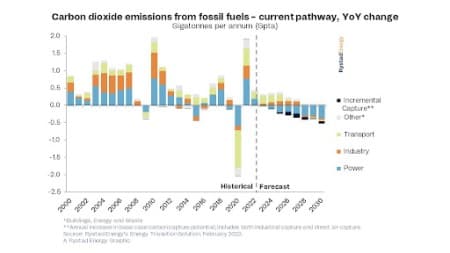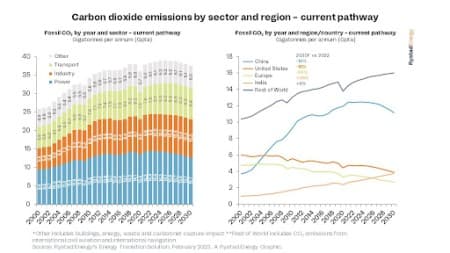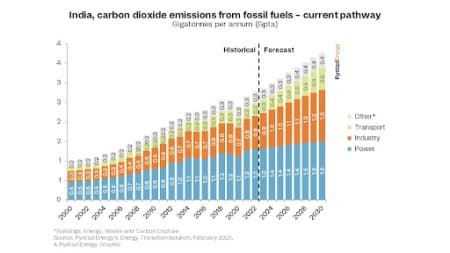The inflection point for fossil fuel carbon dioxide (CO2) emissions is nigh, with emissions on track to peak by 2025, according to Rystad Energy research and analysis. On the current global pathway of announced policies, projects, industry trends and expected technological advancements, global CO2 emissions are poised to hit about 39 gigatonnes per year (Gtpa) in 2025 before settling into a steady annual decline as industries clean up their carbon footprint.
Emissions hit a record high in 2022 as countries scrambled to secure reliable, affordable fuel for power generation on the back of Russia’s invasion of Ukraine. As a result, many turned to more carbon-intensive fuels as a short-term solution to their energy security crises, reviving mothballed coal plants and prioritizing gas over cleaner alternatives. While these fuels will still have a role to play in the global economy for decades to come, the broader push towards a cleaner future is showing no signs of slowing down.
As a sign of things to come, direct CO2 emissions – carbon dioxide originating from fossil fuel combustion at the plants worldwide – from power and heat generation will peak this year. The decline will be minimal initially before gathering momentum in the coming years, becoming a significant factor behind the decrease in total CO2 emissions from all sectors by 2025.
Related: Kazakhstan Could Suspend Natural Gas Exports Next Winter
“Peak fossil fuel CO2 emissions within the next two years is an outstanding global achievement, exceptional when considering the current supply chain roadblocks and the high focus on energy security. If the industry can maintain this momentum, global warming of fewer than 2.0 degrees Celsius is within reach,” said Artem Abramov, head of clean tech research at Rystad Energy.


Fossil CO2 emissions reached an all-time high of about 38.3 Gtpa last year, raising eyebrows and questions about the world’s ability to deliver on ambitious climate goals to limit warming to between 1.5 and 2.0 degrees Celsius. However, our comprehensive emissions modeling points to an imminent emissions inflection point. Our data shows a peak of 39 Gtpa in 2025, but that timeline could move up to as early as next year if the short-term macroeconomic outlook accelerates the energy transition.
Power and heating to drive emissions reductions globally
Last year proved a challenging one for global climate goals. On the one hand, a record amount of new utility-scale solar and wind capacity was added – about 300 gigawatts (GW) globally – triggering a sizeable increase in renewable-generated electricity, a trend that is likely to increase again this year. However, these new installations were weaker than forecast, thanks to low-carbon supply-chain disruptions and inflationary pressure. Moreover, Russia’s invasion of Ukraine fundamentally disrupted energy flows, resulting in widespread natural gas shortages, particularly in Europe, facilitating the increase in coal use for power generation. As a result, direct fossil CO2 emissions from the power and heat sectors hit record highs of around 14.4 Gtpa.
Global industrial emissions (process and direct use of fossil fuels for energy generation purposes at industrial facilities) last year stayed flat at ~9.95 Gtpa as post-Covid recovery in China was offset by a visible decline in Chinese industrial carbon intensity.
Transport emissions increased by 0.2 Gtpa to reach 7.8 Gtpa in 2022 – falling short of pre-Covid peaks of 8.2 Gtpa due to the continued weakness of the aviation sector, triggered by the pandemic and accelerating penetration of electric vehicles (EVs). EV adoption is approaching the levels needed to offset the annual global growth of the size of the active car fleet.
Despite these setbacks, the power and heating sector is expected to drive the upcoming fossil CO2 decline from mid-decade onwards. In 2023, the addition of renewable generation capacity is projected to outstrip the uptick in electricity demand. From 2025, annual renewable generation additions will start materially affecting total fossil fuel output. This trend will also accompany continuous coal-to-gas switching (the persistent trend established several decades ago net of occasional short-term disruptions). Transportation and industrial emissions will peak later this decade but are also expected to join the decarbonization trend in the second half of the 2020s. At the same time, the first generation of large-scale commercial carbon capture initiatives will also start playing non-negligible roles, driven initially by projects in Europe and North America.
While Europe, the US and China make progress, India’s emissions grow
The decarbonization picture differs across regions, and key contributors of emissions are expected to play diverging roles in the coming years. For instance, Europe, the US and China are on track to reduce fossil CO2 emissions by 24%, 18% and 10%, respectively, by 2030. Europe and the US are on a path to structurally decarbonize their economies, leaning into newly implemented clean technology and low carbon policies from 2025 onwards.
The Chinese transport sector is electrifying at a rapid speed, domestic renewable installations are strong, as is its low-carbon supply chain, and it is positioned for an acceleration in industrial decarbonization for energy-intensive sectors in the next five-to-ten years. As a result, we expect Chinese fossil CO2 emissions to plateau this year at about 12.5 Gtpa before declining from 2026 through 2028.
At the other end of the spectrum, India is expected to continue its momentum of expanding CO2 emissions as its economy expands and the population grows. We expect Indian CO2 emissions to increase by 36% between 2022 and 2030, surpassing Europe in 2025 and the US in the early 2030s. We anticipate growing emissions to slow in the 2030s as non-coal power generation steps up to meet incremental electricity demand growth.
Elsewhere, industrial emissions are expected to increase by about 20% by 2030, driven predominantly by other Asian countries (excluding China), which are set to account for half of the increase in total fossil fuel emissions growth.


By Rystad Energy
More Top Reads From Oilprice.com:
- Top 5 Best Oil Stock Performers And 5 Worst Performers
- Attacks On The U.S. Power Grid Are Surging
- U.S. Oil Drilling Activity Retreats For Second Week In A Row



















Now Rystad Energy is shifting its hype to global CO2 emissions telling us that direct CO2 emissions from power and heat generation will peak in 2023 while fossil CO2 emissions will peak in 2025.
This begs the question as to how would Rystad Energy’s projections square up with rising global coal consumption, China building more coal-powered generation plants and India expected to continue its momentum of expanding CO2 emissions as its economy expands and the population grows with its CO2 emissions increasing by 36% between 2022 and 2030.
Rystad Energy tends to start with a projection which long before it is proven it becomes a fact on which it bases its conclusions. It transpires later that it is like building sand castles in the air.
Dr Mamdouh G Salameh
International Oil Economist
Global Energy Expert